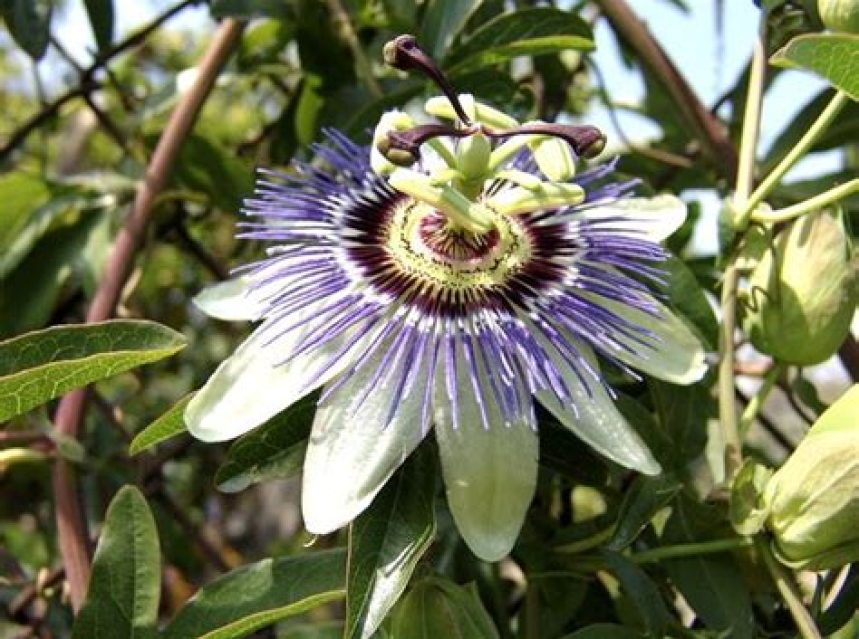The Ultimate Guide to Growing Passiflora Caerulea in Your Garden

Passiflora caerulea, also known as the blue passion flower, is a stunning and fascinating addition to any garden. With its exotic appearance and beautiful blooms, it’s no wonder that many gardeners are eager to cultivate this plant. However, growing passiflora caerulea requires some knowledge and care to ensure optimal growth and health. In this ultimate guide, we will cover everything you need to know about successfully growing passiflora caerulea in your garden. From choosing the right location and preparing the soil to selecting, planting, and caring for passiflora caerulea, as well as dealing with common pests and diseases, we’ve got you covered. Whether you are a seasoned gardener or a beginner, this guide will provide you with all the information you need to create a thriving and beautiful passiflora caerulea garden. So, let’s dive in and learn how to bring the beauty of passiflora caerulea to your garden!
Choosing the Right Location for Passiflora Caerulea
When it comes to choosing the right location for Passiflora Caerulea, also known as the Blue Passion Flower, it is important to consider a few key factors that will contribute to its optimal growth and blooming. The first thing to consider is sunlight. Passiflora Caerulea thrives in full sunlight, so choose a location that receives at least six hours of direct sunlight per day.
Another important factor to consider is the soil. The soil should be well-draining and rich in organic matter. It’s best to avoid heavy clay soils, as they can retain too much water and lead to root rot. Additionally, the ideal pH range for Passiflora Caerulea is slightly acidic, between 6.0 and 6.5.
Furthermore, it’s important to consider the climate of your location. Passiflora Caerulea is best suited for USDA hardiness zones 6 through 9. If you live in a cooler climate, consider planting it in a sheltered spot to protect it from harsh winds and frost. Lastly, consider the support structure for the vine. Passiflora Caerulea is a climbing plant and will need a trellis, fence, or wall to support its growth.
By taking these factors into consideration, you can ensure that you’re choosing the right location for Passiflora Caerulea and setting it up for success in your garden or landscape.
Preparing the Soil for Optimal Growth
When it comes to preparing the soil for optimal growth of Passiflora Caerulea, there are a few important factors to consider. Firstly, it is essential to ensure that the soil is well-draining to prevent waterlogging, which can lead to root rot and other issues. Additionally, the soil should be rich in organic matter to provide essential nutrients for the plant’s growth.
One way to improve the soil quality is by adding compost or well-rotted manure. These organic materials not only provide nutrients but also help to improve the soil structure, allowing for better aeration and drainage. It is recommended to mix compost or manure into the soil before planting the Passiflora Caerulea.
In addition to organic matter, it is important to consider the pH level of the soil. Passiflora Caerulea thrives in a slightly acidic soil with a pH range of 6.5 to 7.5. If the soil is too alkaline, it can be adjusted by adding sulfur or peat moss to lower the pH level.
Overall, the key to preparing the soil for optimal growth of Passiflora Caerulea is to ensure it is well-draining, rich in organic matter, and has a suitable pH level. By taking these factors into account, gardeners can create the ideal growing environment for this beautiful and exotic plant.
Selecting and Planting Passiflora Caerulea
When selecting a Passiflora Caerulea, also known as the Blue Passionflower, it is important to choose a healthy plant with no signs of diseases or pests. Look for vibrant green leaves and check the stems for any discoloration or signs of damage. It’s also essential to choose a plant with a well-established root system, as this will ensure a higher chance of successful growth.
Once you have selected the right Passiflora Caerulea, it’s time to move on to planting it in the proper location. These plants thrive in full sun and well-drained soil, so it’s important to choose a spot in your garden that receives plenty of sunlight throughout the day. Additionally, make sure the soil is rich in organic matter and has good drainage to prevent waterlogging.
When planting the Passiflora Caerulea, dig a hole that is twice as wide and just as deep as the plant’s root ball. Gently remove the plant from its container and loosen the roots before placing it in the hole. Backfill the hole with soil, making sure to firmly press the soil around the base of the plant to remove any air pockets. Finally, water the plant thoroughly to help establish its roots in its new environment.
By carefully selecting and planting your Passiflora Caerulea, you can ensure a strong start for this beautiful and unique flowering vine in your garden. Following these steps will help set the stage for successful growth and a stunning display of colorful blossoms.
Caring for Passiflora Caerulea: Watering, Fertilizing, and Pruning
Passiflora Caerulea, also known as the blue passionflower, is a stunning vine with beautiful flowers that is relatively easy to care for. However, to ensure optimal growth and blooming, it is important to pay close attention to watering, fertilizing, and pruning.
When it comes to watering, it is crucial to keep the soil consistently moist, especially during the growing season. However, it is important to avoid overwatering, as this can lead to root rot. To prevent overwatering, it is best to water Passiflora Caerulea deeply, allowing the soil to dry out slightly between waterings.
For fertilizing, a balanced liquid fertilizer can be applied every two weeks during the growing season. This will provide the plant with the nutrients it needs to support healthy growth and abundant flowering. It is important to follow the manufacturer’s instructions for dilution and application to avoid over-fertilizing, which can lead to salt buildup in the soil.
When it comes to pruning, Passiflora Caerulea should be pruned in early spring to control its size and shape. Pruning can also help to remove any dead or damaged growth, as well as encourage new growth and flowering. It is important to use clean, sharp pruners to make clean cuts and to avoid spreading disease.
Dealing with Common Pests and Diseases of Passiflora Caerulea
Passiflora Caerulea, also known as the Blue Passion Flower, is a beautiful and exotic plant that is susceptible to a few common pests and diseases. It is important to monitor your Passiflora Caerulea regularly to ensure it remains healthy and pest-free.
One common pest that can affect Passiflora Caerulea is aphids. These small insects can cluster on the undersides of the leaves and stems, sucking the sap from the plant and causing damage. To combat aphids, you can use a strong stream of water from a hose to spray them off the plant, or you can use insecticidal soap to control their numbers.
Another common issue that Passiflora Caerulea can face is powdery mildew. This fungal disease can cause a white powdery substance to appear on the leaves, resulting in stunted growth and leaf distortion. To prevent powdery mildew, ensure that your Passiflora Caerulea is planted in an area with good air circulation, and avoid overhead watering, which can promote the spread of the disease.
In addition to aphids and powdery mildew, Passiflora Caerulea can also be susceptible to spider mites and root rot. Spider mites are tiny arachnids that can cause yellow stippling on the leaves and produce fine webbing on the plant. To control spider mites, you can use insecticidal soap or horticultural oil. Root rot, on the other hand, is caused by overwatering and poorly-draining soil. To prevent root rot, ensure that your Passiflora Caerulea is planted in well-draining soil and allow the top inch of soil to dry out between waterings.
Frequently Asked Questions
What is Passiflora Caerulea and why is it a popular choice for gardens?
Passiflora Caerulea, also known as the blue passionflower, is a beautiful and easy-to-grow vine that is popular for its striking flowers and edible fruits. It is a favorite among gardeners for its ornamental value and the wildlife it attracts.
How do I choose the right location for growing Passiflora Caerulea?
Passiflora Caerulea thrives in full sun to partial shade. It’s important to choose a location with well-draining soil and some support for the vine to climb. A south-facing or west-facing wall is ideal for providing the warmth and sunlight the plant needs to flourish.
What are the key steps for preparing the soil for optimal growth of Passiflora Caerulea?
To prepare the soil for Passiflora Caerulea, make sure it is rich in organic matter and well-draining. You can amend the soil with compost and peat moss to improve fertility and structure. Also, ensure the soil pH is slightly acidic, around 6.5 to 7.0.
How should I select and plant Passiflora Caerulea in my garden?
When selecting Passiflora Caerulea, choose a healthy plant with well-established roots. Dig a hole twice as wide as the plant’s rootball and place the plant in the hole, gently backfilling with soil. Make sure to water the plant thoroughly after planting to help it establish in its new location.
What are the key points to keep in mind for caring for Passiflora Caerulea, including watering, fertilizing, and pruning?
For watering Passiflora Caerulea, it’s important to keep the soil consistently moist but not waterlogged. Fertilize the plant with a balanced fertilizer in spring and summer to promote healthy growth. Pruning should be done in late winter or early spring to remove dead or damaged growth and encourage new growth.
What are some common pests and diseases that affect Passiflora Caerulea, and how can I deal with them?
Common pests that may affect Passiflora Caerulea include aphids, caterpillars, and whiteflies. Diseases such as powdery mildew and leaf spot can also occur. To deal with these issues, you can use insecticidal soap for pests and fungicides for diseases, following the instructions carefully.
What are some additional tips for ensuring the successful growth of Passiflora Caerulea in my garden?
In addition to the aforementioned care tips, it’s important to provide support for the vine to climb, such as a trellis or arbor. Also, regular monitoring for pests and diseases, as well as proper mulching, can help maintain the health and vigor of Passiflora Caerulea in your garden.



